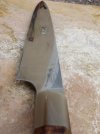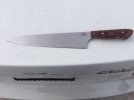I'm still relatively green to this hobby (only about 20 smallish knives so far) and I had the idiotic idea that I might try my hand at a larger blade. This is a 8'' chef blank which I forged from a Nicholson rasp.

I know, I know, mystery steels are heresy but I've made most of my knives from old Nicholson files, it is just what I am familiar with. I used to get loads of the from the farrier I worked for in the summer.
This is the largest knife I have attempted so far and I was really happy with how accurately I managed to forge it to. I am just a little stumped as how to smoothly transition from blade to handle. I really don't want a plunge line as it is a look I personally hate in chef knives and would seem like a really good place for rust to collect. My current approach has been to grind the bevel at a diagonal and then allow the blade to tradition to the flat tang in a kind of radius around the heel of the blade which, at least in my head, works (I hope all that made at least a little sense). Anyway, I was wondering what you wise fellas would do to tackle this particular dilemma of mine. Any help is sorely needed and greatly appreciated.

I know, I know, mystery steels are heresy but I've made most of my knives from old Nicholson files, it is just what I am familiar with. I used to get loads of the from the farrier I worked for in the summer.
This is the largest knife I have attempted so far and I was really happy with how accurately I managed to forge it to. I am just a little stumped as how to smoothly transition from blade to handle. I really don't want a plunge line as it is a look I personally hate in chef knives and would seem like a really good place for rust to collect. My current approach has been to grind the bevel at a diagonal and then allow the blade to tradition to the flat tang in a kind of radius around the heel of the blade which, at least in my head, works (I hope all that made at least a little sense). Anyway, I was wondering what you wise fellas would do to tackle this particular dilemma of mine. Any help is sorely needed and greatly appreciated.



